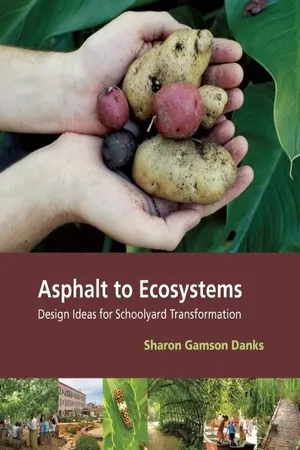
- English
- ePUB (mobile friendly)
- Available on iOS & Android
About this book
Case Studies from North America, Scandinavia, Japan, and Great Britain demonstrate natural outdoor teaching environment that support hand-on learning in science, math, language, and art in ways that nurture healthy imagination and socialization
Asphalt to Ecosystems is a compelling color guidebook for designing and building natural schoolyard environments that enhance childhood learning and play experiences while providing connection with the natural world. With this book, Danks broadens our notion of what a well-designed schoolyard should be, taking readers on a journey from traditional, ordinary grassy fields and asphalt, to explore the vibrant and growing movement to "green" school grounds in the United States and around the world. This book documents exciting green schoolyard examples from almost 150 schools in 11 countries, illustrating that a great many things are possible on school grounds when they are envisioned as outdoor classrooms for hands-on learning and play.
The book's 500 vivid, color photographs showcase some of the world's most innovative green schoolyards including: edible gardens with fruit trees, vegetables, chickens, honey bees, and outdoor cooking facilities; wildlife habitats with prairie grasses and ponds, or forest and desert ecosystems; schoolyard watershed models, rainwater catchment systems and waste-water treatment wetlands; renewable energy systems that power landscape features, or the whole school; waste-as-a-resource projects that give new life to old materials in beautiful ways; K-12 curriculum connections for a wide range of disciplines from science and math to art and social studies; creative play opportunities that diversify school ground recreational options and encourage children to run, hop, skip, jump, balance, slide, and twirl, as well as explore the natural world first hand. The book grounds these examples in a practical framework that illustrates simple landscape design choices that all schools can use to make their schoolyards more comfortable, enjoyable and beautiful, and describes a participatory design process that schools can use to engage their school communities in transforming their own asphalt into ecosystems.
Frequently asked questions
- Essential is ideal for learners and professionals who enjoy exploring a wide range of subjects. Access the Essential Library with 800,000+ trusted titles and best-sellers across business, personal growth, and the humanities. Includes unlimited reading time and Standard Read Aloud voice.
- Complete: Perfect for advanced learners and researchers needing full, unrestricted access. Unlock 1.4M+ books across hundreds of subjects, including academic and specialized titles. The Complete Plan also includes advanced features like Premium Read Aloud and Research Assistant.
Please note we cannot support devices running on iOS 13 and Android 7 or earlier. Learn more about using the app.
Information
Table of contents
- Cover
- Title Page
- Copyright
- Contents
- Foreword
- Preface
- Dedication
- Part 1 Getting From Here to There
- Part 2 Ecological Teaching Tools in the Schoolyard
- Part 3 Creating a Diversified Play Environment in an Ecological Schoolyard
- Part 4 Shaping Schoolyard Infrastructure to Create Comfortable, Effective and Memorable Places
- Part 5 Putting Ideas into Action
- Appendices
- Referenced Works
- Endnotes
- Acknowledgements
- Subject Index
- About the Author
- About New Village Press